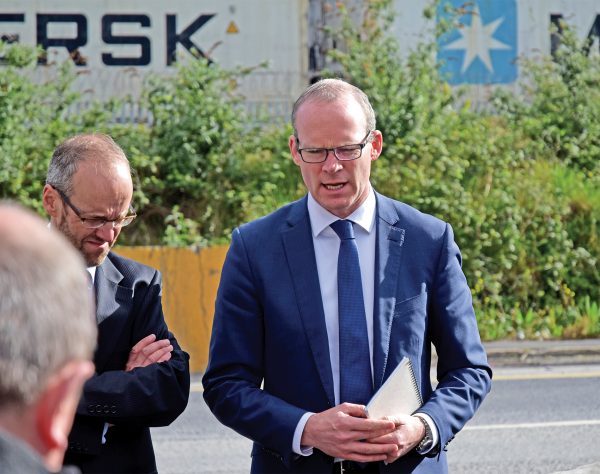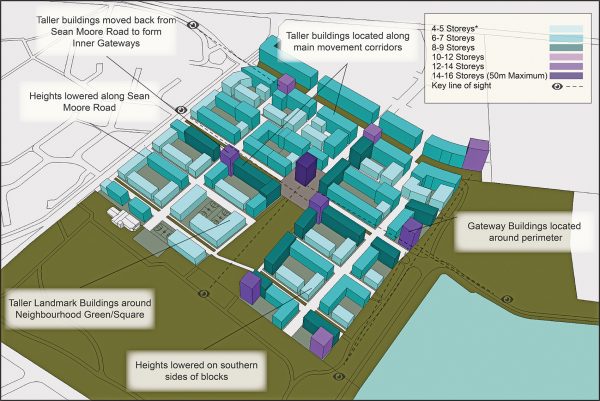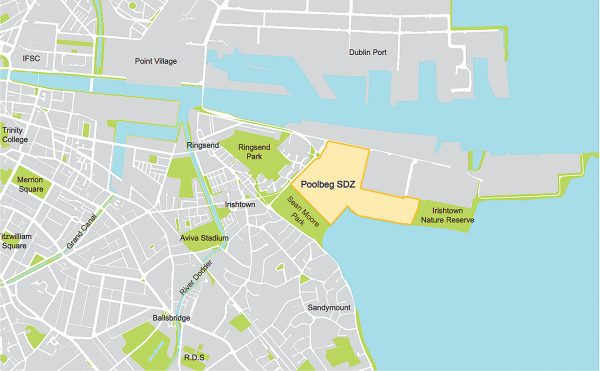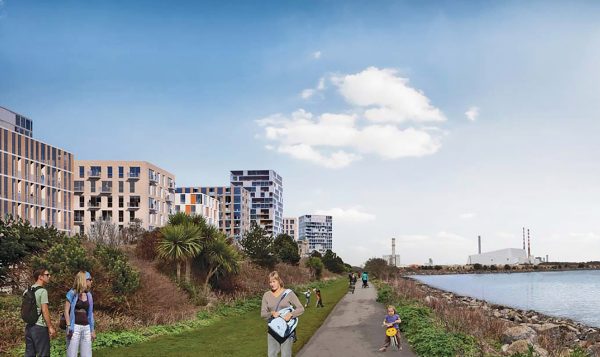
Pictured: Minister Coveney talks with locals at the SDZ site.
Photo by Kevin O’Gorman.
Agreement has been reached on an allocation of 25% social housing in the Poolbeg West SDZ that has been the subject of much lobbying and speculation regarding the potential housing and commercial mix. Councillors of Dublin City Council have voted last month to include up to 900 social housing units on the new Poolbeg West site.

Pictured: 3D perspective of proposed development.
Locals have been campaigning for a substantial social and affordable housing provision on the IGB site as part of the overall SDZ development, so that local families can remain in the area and not be ‘priced out’ due to the proposed development.
A meeting at the Irish Glass Bottle (IGB) factory site involving Minister for Housing, Simon Coveney and members of the IGB Housing Action Group and local political representatives occurred on April 13th.
The event followed a public meeting at Ringsend and Irishtown Community Centre on the evening of April 12th where locals discussed concerns regarding the amount of social and affordable housing provision under the upcoming development of the Poolbeg Strategic Development Zone (SDZ). The development zone includes the vacant IGB site currently under NAMA-managed receivership.
At the site meeting, Minister Coveney spoke of the IGB development as “arguably the most ambitious residential project in the country,” and as “the flagship development of the country in terms of how to develop communities in the future.”

Pictured: Map of the site and surrounding area.
Outlining what appears to be a relatively ‘hands off’ position on his involvement in the development process, the Minister explained that he sees it as his job “to try to impact on the key decision makers to make sure this isn’t simply just a maximising-of-profit site, that it actually contributes to the broader community in a very positive way.”
He added: “Having said that, the receiver has legal obligations too, and of course DCC needs to approve the master plan, so the receiver knows that if they are not willing to talk in a progressive way about how to build the right community here, rather than just building houses and apartments, then they’ll have to get a master plan that allows them to move the site on. So there are a number of different players here who are all contributing.”
He went on to reiterate that, as he sees it, responsibility for the final SDZ development plans lies squarely with DCC councillors: “I don’t want to over-promise in terms of what I can do on influencing that. I obviously have some part to play in that, as the Minister has a role in the putting together of the master plan for a SDZ like this one, but ultimately it will be councillors who actually vote on it.”
The Minister explained that he foresaw 3,000 residential units on the IGB site with a population of around 10,000 people, “hopefully living in a really dynamic community with open space, with people looking over the harbour, with boardwalks and cycleways, and all the other things that a modern, urban community should have.” A projected population of 10,000 is much higher than the figure of 7,000 proposed in previous plans.
Speaking of the special status of the IGB site, Minister Coveney continued: “This is not like a lot of the other SDZs because it is not publically owned land, even though it’s NAMA controlled land. There is a difference legally. In effect, there is a receiver managing the site.”
Long-term campaigner for social and affordable housing in the area, Patsy Doolin of the IGB Housing Action Group, responded to Minister Coveney’s visit saying: “The meeting was very successful. I think the minister himself is a genuine man and he knows what has to be done. The site is big enough to be able to do what we’re asking around social and affordable housing.”
After the initial IGB site meeting, Doolin and other representatives of the IGB Housing Action Group brought the Minister to nearby Poolbeg Quay, where there is a successful affordable housing project that was set up by a community-led co-op to provide affordable housing solutions for the local community.
“We brought the Minister here to show him what can be done,” Doolin said. “Like there’s apartments and houses and a green space and parking for people here. It’s very important that we get affordable housing. We will get social housing, we have to get social, because there’s so many people on the housing list, but there’s no mechanism in the development plans at the moment for affordable housing provision, so we’re pushing and pushing for that, because we know that there’s loads of young couples out there who can’t even rent in the area because it’s so expensive. They are on their mother’s floor, or their auntie’s floor. It’s really sad to see it.”
“This area is really vibrant. It wants to develop, but it wants to keep its community as well. You’re not going to keep the schools and clubs and community groups going if we keep sending young couples out to the sticks and nothing here for them.”
Such concerns regarding insufficient social and affordable housing provision were expressed to the Minister at the IGB site meeting when locals pointed out to him that there are currently no formal mechanisms or provisions within the SDZ draft plans to deliver affordable housing for sale and rent on the IGB site above the current minimum legal requirement of just 10% social housing. This figure is flatly rejected by local housing campaigners.

Above: The view of the proposed development from Sandymount/Ringsend Nature Park.
We made the point to the minister that we know that NAMA needs to get back as much money as it can on the site, but that even if it just sold a quarter of the site to the market it could probably get back at least what it paid for it, which was only 36 million. Therefore, there’s a great opportunity here for the state to seriously change housing provision in this area and in the city.”
At the time of the minister’s visit, Price was cautiously optimistic that the level of provision would exceed the 10% minimum which is the current legal requirement: “The minister is not committing himself, but we have some confidence because of the work that he has been doing that he is serious about hoping to change the law.”
Although the housing group was hoping for an even higher percentage of social housing in the area, the achievement of 25% social housing represents a good return given the 10% minimum as decreed by law. The “commercial agreement” between the council, the Department of Housing and the owners and developers to increase the social provision indicate conditions for “confirmed funding” from the government and the provision of infrastructure such as the planned bridge over the mouth of the Dodder and an extra cycle and pedestrian bridge beside the Tom Clarke bridge.
In the vote at City Hall for the social housing provision, Sinn Féin had put down an amendment asking for an extra 100 homes for senior citizens. However, Chief Executive, Owen Keegan, said 900 was as much as could be achieved and any extra demand would lead to appeal by the receivers to An Bord Pleanála and that could result in the bare minimum 10% social provision.
By Harry Bradley and Ferg Hayden



